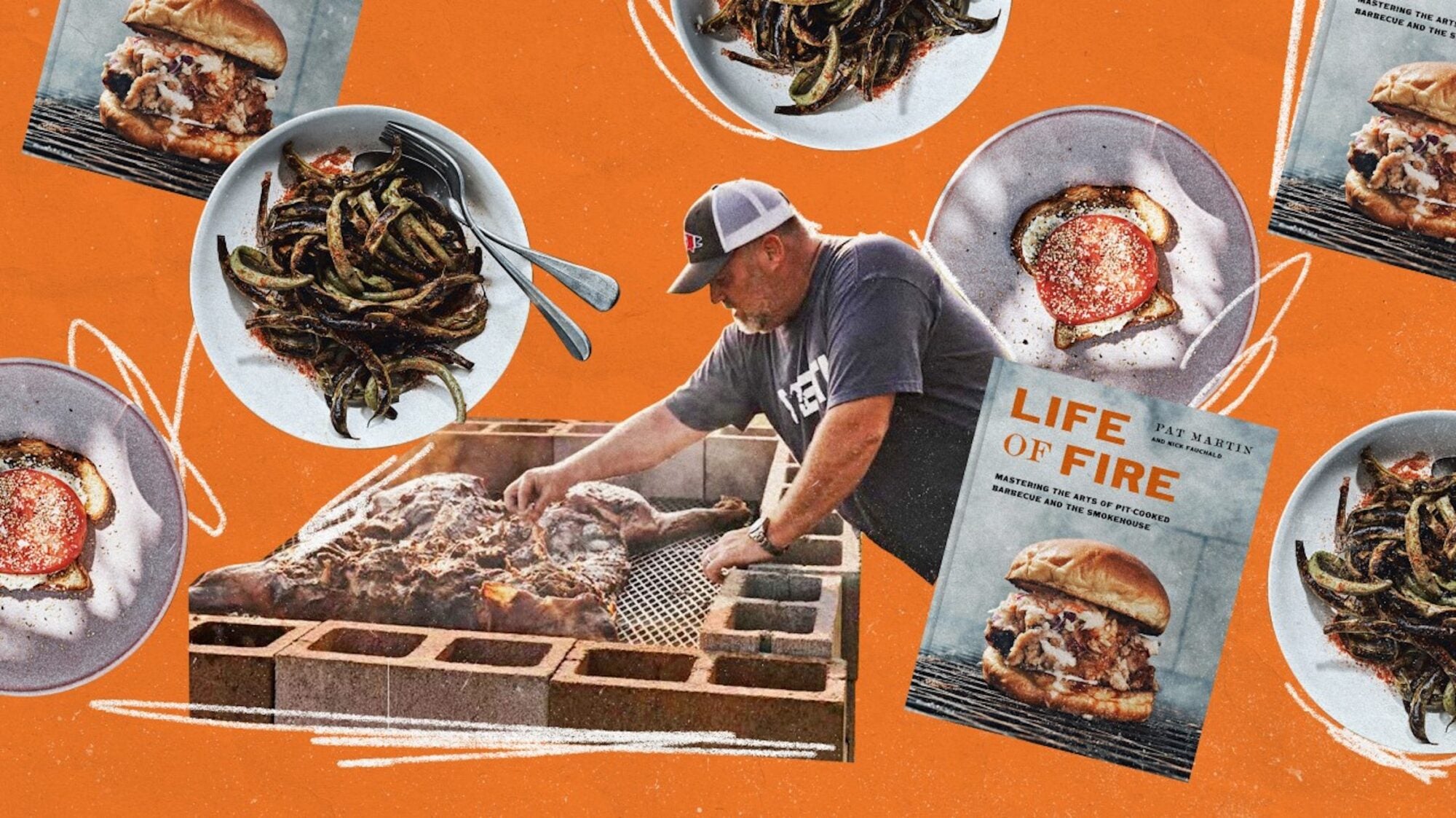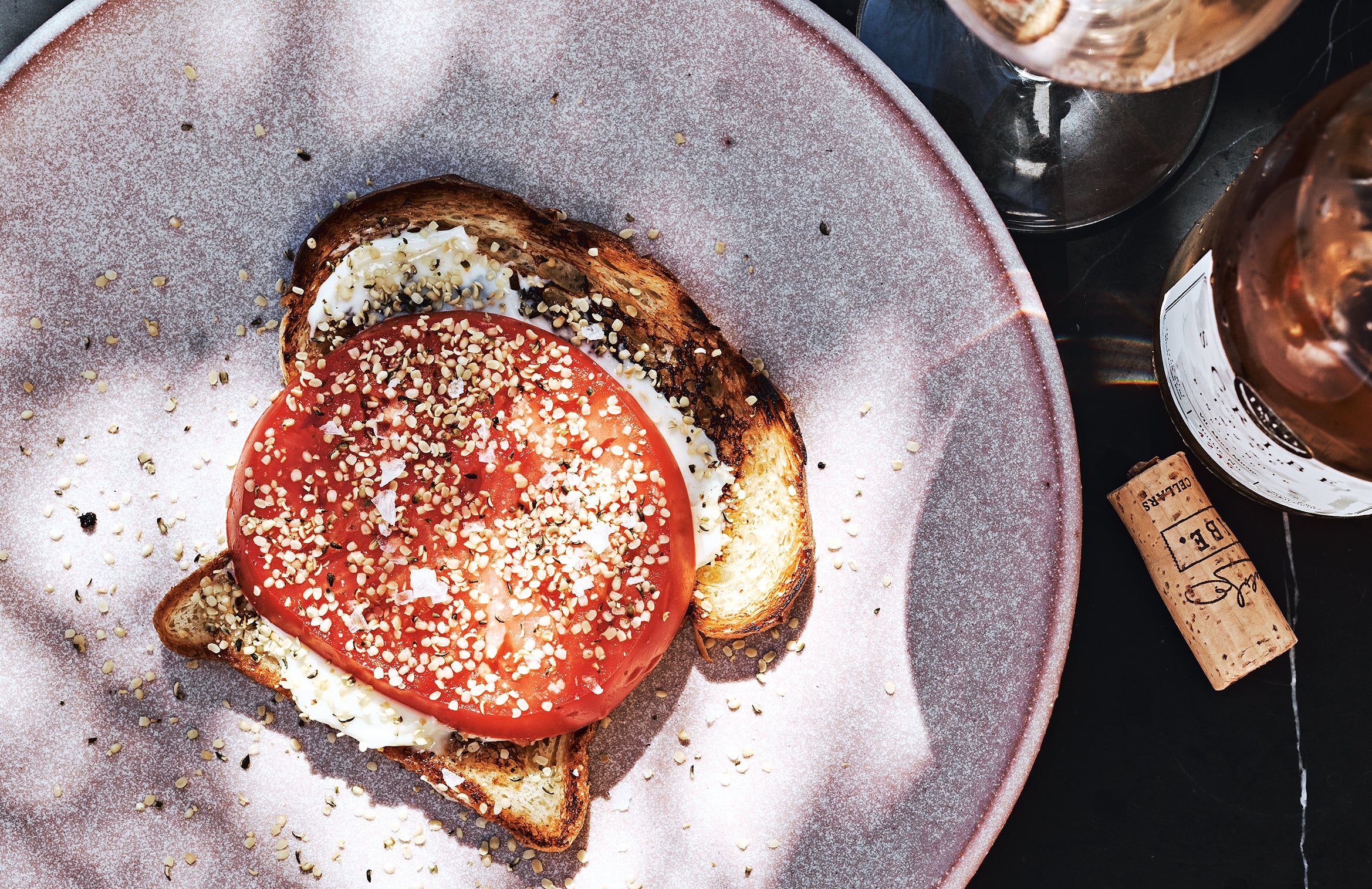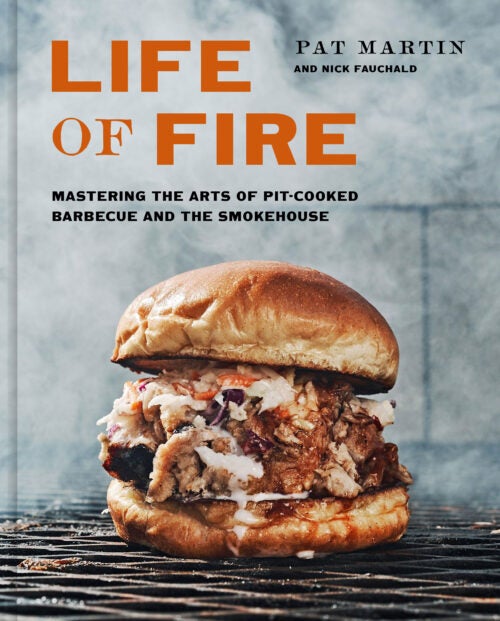
In his first cookbook, legendary pitmaster Pat Martin preaches procedure over cups and tablespoons.
Pat Martin—a Nashville pit master with more than a dozen barbecue spots across Tennessee, Kentucky, Alabama, and South Carolina—would be the first to tell you that if you’re looking for a quick chicken thigh grilling guide for Father’s Day, his new book is not it. He will even admit that Life Of Fire: Mastering the Arts of Pit-Cooked Barbecue, the Grill, and the Smokehouse can be at times “arduous,” as he puts it.
Martin does barbecue—as in meat cooked slow in a hand-built pit or on a spit—and specifically West Tennessee–style whole hog barbecue. His book includes a dissertation on that topic, pretty much, from curing your wood to keeping yourself in coals with your very own burn barrel. The rest of Martin’s book is an education, too, even the recipes that don’t require building a cement-block pit—even his mother’s coconut sheet cake, which she made for his first restaurant in its early days. Beyond the desserts, the bulk of the book is organized around using the fire you have: hot coals for charred tomato and Duke’s mayonnaise sandwiches; mature coals for spit-roasted pork loins; dying embers for ash-roasted beets; smoke for hams cured with molasses and red pepper flakes.
Earlier this month, I caught up with Martin over Zoom to talk about his approach to teaching proper barbecue technique. “You can’t dumb it down to a Weber grill, and that is by design,” he says. “We’re not gonna hide from the work and the effort and the time and everything it takes to do all this, especially cooking a 200-pound hog.”
Andrew Zimmern blurbed this as “the most important book on cooking over live fire in decades.” And then Matty Matheson, he’s like, you’re a “legend,” a “god,” and a “higher power.” And Guy Fieri said you had the “true soul and tradition of pit barbecue.” That’s pretty impressive—how did that all make you feel?
Flattered is an understatement. I was flattered that they would write the blurbs for me. Especially Zimmern’s—it kind of put me down in my seat a little bit. I was like, “Golly, man.” It’s almost embarrassing, you know? But I love him, and he loves me, and I really appreciate that all these guys love and respect my food, and I couldn’t ask for anything more.
They all came to you in Tennessee, to eat at your place?
Oh, yeah, over the years. I mean, I’m kind of like an old man in barbecue now, which I can’t believe, after 15 years. I think I’ve done all the shows on the Cooking Channel and the Food Network. Tony Bourdain came to my house, and we cooked for No Reservations. So I’ve kind of been in around all of them, and we all became good friends.
I was wondering about your approach to cooking with fire over the years. Has that changed over time?
No, I’m pretty rigid about that. My guys, when they’re cooking hogs at the joint, they know when the coals are ready or not. When they have a gray ash on them, they’re not completely ready—they’ve gotta really get burned down. Think about it as right when the fire looks like it’s going to peak and the coals are starting to die—that’s when they’re usable, and you grab them for using for the hog.
It’s those details that I think are the beauty of your book. If somebody goes straight to a recipe, they’re missing everything.
Yeah, they are. It’s not a recipe book, it’s a procedure book. When Francis [Lam, the editor of the book] and I were first starting to talk about what the book would be, I started off by telling him what I did not want it to be. And he said, “Well, give me some ideas of books that you like, just to get my head wrapped around where you are, Pat.” And I used Cooking by Hand by Paul Bertolli as an example, which is like a Bible for me on Italian cooking.
The most important stuff in your book is in these long prose passages—you really gotta read it.
It was prose by design, because I was inspired by Paul’s book and how he wrote about pasta. It’s like he was talking to me. I wasn’t sitting there, reading down the bullet points of a recipe. I think you get lost, you lose the nuances, you lose the author’s voice when you’re just reading a recipe. The thing is, up until Rodney Scott and Sam Jones just did their books with whole hog—and they’re two very dear friends of mine—any other barbecue book you picked up, if they even took the time to put in “a recipe”—and I’ve used this in quotes—for cooking a whole hog and barbecue, they completely wasted their time, because it would be like one page. “Take a 150-pound hog and a quart of salt, turn to this sauce recipe that we have for you, cook it for twelve hours, flip it at six, and go on.” You can’t ever be successful. The lack of information’s almost a slap in the reader’s face. What I wanted to do was almost mentor you through that procedure, and that procedure’s about 33 pages long, just to cook a hog.
“The lack of information’s almost a slap in the reader’s face.”
It’s 33 pages, but that’s like your entire life experience in 33 pages.
Yeah, it is. That’s why there is no recipe for cooking whole hog barbecue. Really, you could even make the argument that there can’t be a recipe for barbecue. Barbecue is so skill-driven, and it’s procedural. I’m not saying that recipes don’t matter. I have recipes in my book for barbecue, but that’s not the only vehicle we can use to express it. But it’s not like making biscuits. It’s not like cooking an inch-and-a-half-thick New York strip steak for four minutes on this side, two and a half on the other. It’s just not that way. It’s the guy who’s got the shovel, who’s there at the moment. It could be windy. The barometric pressure could be dropping. Your wood could have water in it. So this was my stab at getting you as close as I can possibly get you to being successful at doing this, without being there with you.

THREE EXCITING RECIPES FROM LIFE OF FIRE:
Martha’s Open-Faced Grilled Tomato Sandwiches
Chilling the tomatoes first is the secret to fast, smoky flavor.
Grilled Green Beans with Memphis Rub
Crispy, smoky, sweet, and spicy, Martin often serves these as a snack.
Coconut Cake
The Southern sheet cake ne plus ultra from Martin’s mother, Pam.
